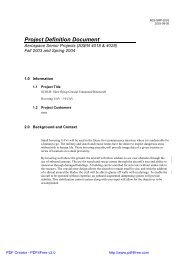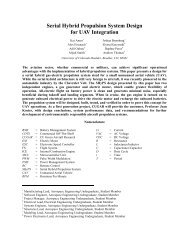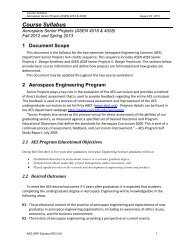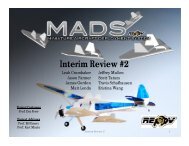PFR - Aerospace Engineering Sciences Senior Design Projects ...
PFR - Aerospace Engineering Sciences Senior Design Projects ...
PFR - Aerospace Engineering Sciences Senior Design Projects ...
Create successful ePaper yourself
Turn your PDF publications into a flip-book with our unique Google optimized e-Paper software.
Project Final Report – CUDBF April 30 th , 2009<br />
ASEN 4028: <strong>Aerospace</strong> <strong>Senior</strong> <strong>Projects</strong><br />
With this analysis complete, 14AWG wire was chosen because it proved to be the lowest weight<br />
option. The 32 amp continuous rating will ensure that the wire will not overheat, and short 40<br />
amp bursts will be handled by the wire.<br />
9.1.5 Fuse<br />
Competition rules state that the propulsion system must contain a 40 amp fuse placed such that<br />
no portion of the propulsion system sees more than 40 amps of continuous current. A Cooper-<br />
Bussmann [29] ATC style 40 amp blade fuse was chosen to meet this requirement. The fuse is<br />
rated for 40 amps of continuous current, with up to 80 amps in short bursts less than 10 seconds.<br />
The fuse will be placed just behind the battery pack right before the power splits to both motors.<br />
This will allow the fuse to be easily accessible from the top of the wing for easy arming and<br />
disarming. An image of the fuse is shown in Figure 80.<br />
Figure 80: 40 Amp Fuse<br />
9.2 Avionics Electrical <strong>Design</strong> Elements<br />
9.2.1 Avionics Electrical Overview<br />
The overall responsibility of the avionics subsystem is to implement the communication system<br />
between the pilot and the plane and to use a telemetry system to record the necessary flight<br />
characteristics.<br />
The communication system will consist of a transmitter and receiver that will be able to control<br />
the servos that are connected to the control surfaces, electronic speed controllers, microcontroller<br />
and the releasable payloads. Figure 81 illustrates that six channels will be required for the<br />
transmitter and receiver. Four channels will be utilized to control the aircraft, one will be needed<br />
for the payload release system, and the last channel will be used to control the propulsion system.<br />
104
















